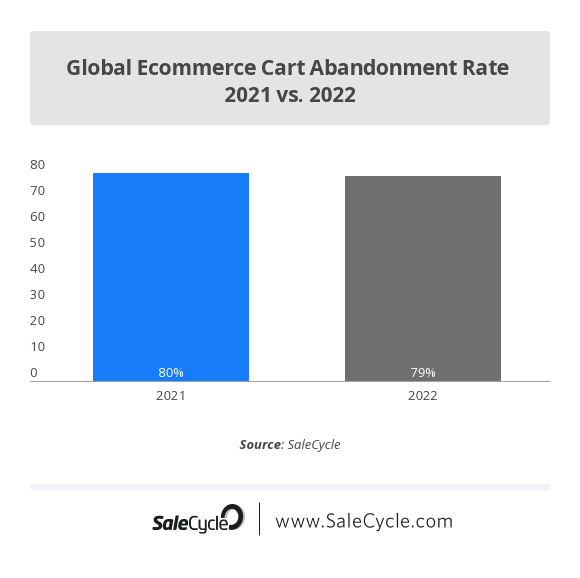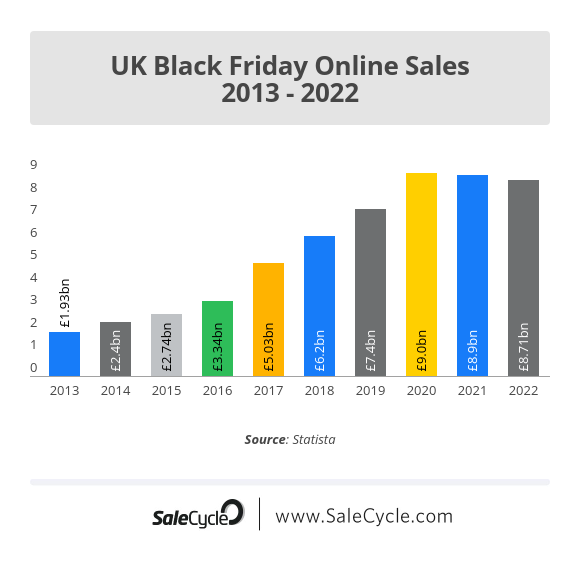Discounts are a common tactic used by online retailers, but is there a risk that customers are being trained to look for them? Should they be a feature of cart abandonment emails?
In a nutshell, people are deliberately abandoning purchases in the belief that a shopping cart abandonment email will follow with a nice discount for them, and it is this that is pushing up abandonment rates.
However, offering promo codes and discount do increase conversion rate so this is a double-edged sword.
We track abandonment rates and, while there is some fluctuation, they have remained relatively steady over the last few years.
The latest figure we have is from the 2023 Ecommerce Stats & Trends Report, which shows abandonment rate on average is 79% though it will vary by industry and device.

Retailers can improve the checkout process , eliminate issues with checkout forms, payment etc, but there will always be a certain amount of abandonment, simply because most people will not decide to buy on the first visit.
Retailers can apply several improvements to optimise their ecommerce checkout process, including making improvements to their best ecommerce product pages and also taking direction from conversion rate optimisation services, which SaleCycle offers.
It’s important for ecommerce brands to think about mobile vs desktop conversion rates, which may differ depending on industry. Here retailers should concentrate on things like their mobile forms design to increase conversions.
Do Customers Expect Abandoned Cart Discount Codes?
However, the issue of discounts is worth exploring, as there is evidence that customers are being trained to expect discounts.
There are some brands customers could be reluctant to buy from at full price, as they offer discounts so regularly.
For example, emails offering price reductions several times a month from Gap – this is a snapshot from November last year. 

Likewise, the appearance of a coupon code box on an e-commerce checkout can be a signal to shoppers that there might be a discount on offer.
Here, a shopper on Macy’s may be happy enough to pay the full price for these boots, but the presence of the promo code box is a signal that they might just be able to save some money.

A natural response would be to turn to Google and check out one of the sites offering codes for Macy’s. The result could be that the retailer fails to sell the boots at full price.

Abandoned Cart Discount Code Ideas
Shoppers have always looked for a bargain, and the internet has made it easier in many ways for customers to find the best deal.
Comparison engines, deals sites like Groupon, and the many voucher code sites all appeal to the bargain hunter, and reinforce the idea that the deals are out there if you look hard enough.
One such example is Pouch, a browser extension that alerts shoppers to any discount codes which may be available on the sites they visit, so people don’t even need to search Google for deals.

Consumers have caught on to the fact that some abandoned cart emails offer discounts. For example, this ‘shopping secrets’ post on Money Saving Expert advises people to abandon baskets in case you receive a discount code.

The problem for retailers is that, while discounts are attractive to customers and a great tactic for boosting short-term sales, it has an inevitable impact on profitability.
As Kevin Hillstrom explains in this post, there is an obvious relationship between the level of discounting and profit.

To summarise Kevin’s point, a business that doesn’t feel the need to discount (Apple for example) in is the healthiest position, and one that does use discounts but modestly and infrequently (perhaps to clear older stock) is also is a good position.
However, the businesses which discount almost constantly can be harming their own profits, while also becoming caught in a trap – once you’ve trained your customers to expect discounts, the ‘standard’ price of your products seems very expensive indeed, and it’s hard to escape the cycle.
This brings us to Black Friday and the Christmas shopping season, a time when customers expect ever more attractive discounts from retailers.
But this is also the best days for ecommerce sales and the busiest shopping months of the year so it’s natural for customers to wait for the discounts.
In the UK, where Black Friday is a relatively recent phenomenon, there’s been some pushback from retailers, with some well-known brands deciding not to take part.
This is because discounting relatively early in the season tends to affect sales nearer Christmas Day. So retailers can end up selling more earlier, but at reduced margins.
Our sales data backs this up. Black Friday 2021 was busier in terms of sales volume than the busiest day in December, while abandonment rates were significantly lower.

This doesn’t mean that discounting isn’t a worthwhile strategy though. If used wisely, the long-term value of the customers acquired through discounting will outweigh the reduced margins.
For example, retailers are able to increase new customer acquisition by offering discounts off first purchases.
This is a sensible discounting strategy with relatively modest discounts, and if retailers retain a good proportion of those buyers, then the reduced value of the initial conversions will have been worth it. Which brings us back to the original post about offering discounts in cart abandonment emails.


Do Discounts In Abandoned Cart Emails Increase Cart Abandonment?
The short answer, based on our data, is no. We haven’t spotted a pattern that suggests discounts reduce abandoned carts or vice versa.
With any discounting strategy, whether through email or other channels. retailers have to weigh the aims of promotions against the value of conversions.
If promotions are offered around key goals like new customer acquisition or expansion into new markets, then discounting can be a very effective strategy.
If retailers retain the customers they acquire in this way, their lifetime value makes the strategy worthwhile.
For cart abandonment emails, there is the option of adding discounts to second and third cycle emails, segmented according to factors like higher basket value or perhaps to target a particular geographical region.
Discounts can also be used for a short time, perhaps related to an on-site promotion, so that customers don’t come to expect price reductions every time they make a purchase.
The key point is that discounts should either be profitable for retailers, or should help them to achieve a particular goal.
Alternative Discounting Tactics
Discounting is a conundrum for retailers, but there are ways to use discounting without too much damage to margins, or brand perception.
Use vouchers and gift cards rather than discounts
Using incentives like gift vouchers can be a good alternative to discounts. For example, this email sent by Apple on Black Friday offered a gift voucher with every purchase, to be redeemed in future.

This means people are still making the intitial purchase at full price, and also gives them an incentive to return and but again.
Limited sales periods
‘Always on’ sales, unless they’re specifically to offload unwanted stock, will train customers to always expect a discount.
For example, I wouldn’t buy from some pizza chains without a voucher, as they’re always available if you look for them.

This doesn’t mean that Pizza Express and others are wrong to do this – they may still be making a good profit at these reduced prices and driving more people to their restaurants through these offers.
However, some retailers may become trapped within such a strategy, so it’s a good idea to have sales only for limited periods of the year, so that this still remain special events in customers’ minds.
Don’t Discount Too Heavily
It’s easy to follow suit when rivals are offering generous discounts around sales events like Black Friday, but it’s important to keep an eye on the numbers.
If the extra margin you make from the uplift in sales does not offset the discount you put on products, events like Black Friday can diminish your profits.

Use Discounts as a Carrot to Increase AOV
If you are offering discounts, use them to persuade customers to spend more.
For instance, products could be bundled together so that shoppers buy accessories and related products to make savings.

Use Free Delivery Thresholds
Instead of discounting products, retailers can use free delivery as the carrot.
This reduces the risk of making full-price seem expensive to shoppers, but also gives them the sense that they’re getting a good deal.

It also helps to increase order values, as people are tempted to add more items to their carts to qualify for the offer.
In Summary
So should retailers offer discounts in remarketing emails? Well, they can work well enough without discounts so retailers would be best advised to try this approach first of all.
However, it can depend on what retailers are trying to achieve with abandonment emails. If the goal is to maximise profit, then discounts are likely to impact that.
If new customer acquisition, or perhaps expansion on a particular market is the goal, then discounts can help, and the tactic can pay off in long-term customer value.
Used tactically, it can achieve short-term goals like clearing older stock or increasing customer acquisition, but too many discounts dilutes the effect and reduces profit margins.
Speak to an expert
Learn how to convert your online audience into revenue with our experts.


Brad Ward
Brad Ward is the SEO & Content Manager at SaleCycle. Brad is a former magazine journalist with over 8 years experience in digital, including SEO, social media and copywriting. Brad has written thousands of articles for a range of different sectors including online gambling, travel, education, sports and ecommerce.







![Valentine’s Day Ecommerce Tips and Trends [2024 Strategy]](https://www.salecycle.com/wp-content/uploads/2019/01/valentines-ecommerce-1.png)




![How SaleCycle helped Vodafone increase their online sales by an additional 2,000 additional sales per month [Extended Version]](https://www.salecycle.com/wp-content/uploads/2023/08/vodafone-banner.webp)





